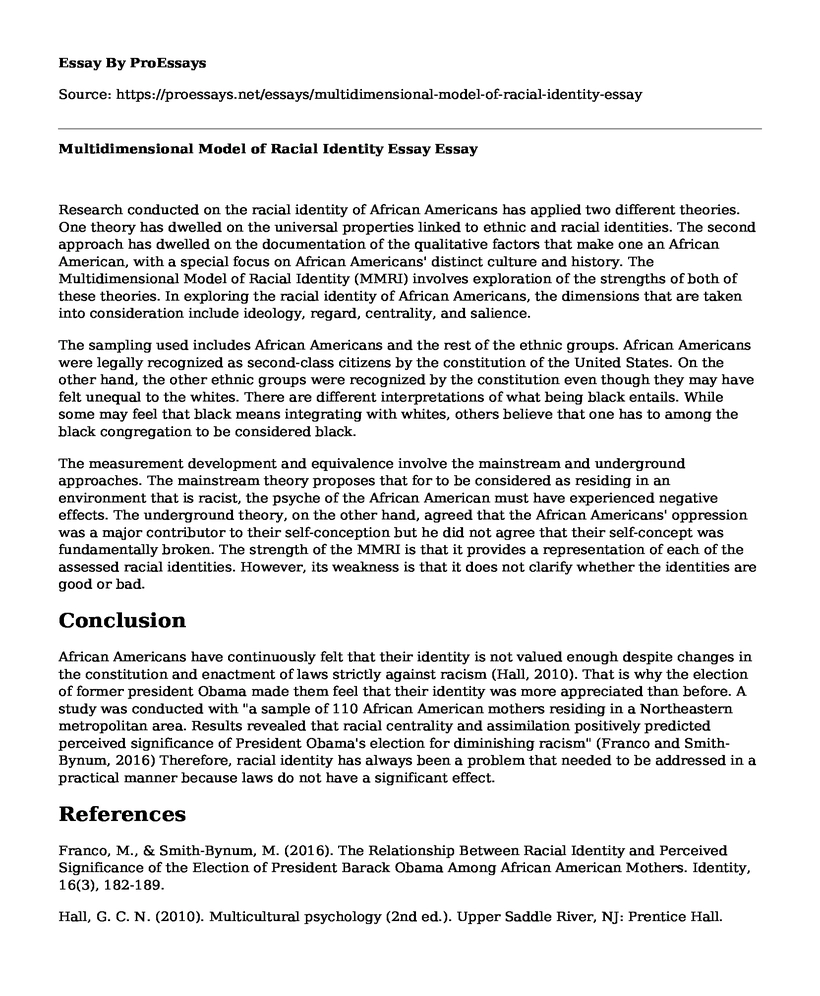Research conducted on the racial identity of African Americans has applied two different theories. One theory has dwelled on the universal properties linked to ethnic and racial identities. The second approach has dwelled on the documentation of the qualitative factors that make one an African American, with a special focus on African Americans' distinct culture and history. The Multidimensional Model of Racial Identity (MMRI) involves exploration of the strengths of both of these theories. In exploring the racial identity of African Americans, the dimensions that are taken into consideration include ideology, regard, centrality, and salience.
The sampling used includes African Americans and the rest of the ethnic groups. African Americans were legally recognized as second-class citizens by the constitution of the United States. On the other hand, the other ethnic groups were recognized by the constitution even though they may have felt unequal to the whites. There are different interpretations of what being black entails. While some may feel that black means integrating with whites, others believe that one has to among the black congregation to be considered black.
The measurement development and equivalence involve the mainstream and underground approaches. The mainstream theory proposes that for to be considered as residing in an environment that is racist, the psyche of the African American must have experienced negative effects. The underground theory, on the other hand, agreed that the African Americans' oppression was a major contributor to their self-conception but he did not agree that their self-concept was fundamentally broken. The strength of the MMRI is that it provides a representation of each of the assessed racial identities. However, its weakness is that it does not clarify whether the identities are good or bad.
Conclusion
African Americans have continuously felt that their identity is not valued enough despite changes in the constitution and enactment of laws strictly against racism (Hall, 2010). That is why the election of former president Obama made them feel that their identity was more appreciated than before. A study was conducted with "a sample of 110 African American mothers residing in a Northeastern metropolitan area. Results revealed that racial centrality and assimilation positively predicted perceived significance of President Obama's election for diminishing racism" (Franco and Smith-Bynum, 2016) Therefore, racial identity has always been a problem that needed to be addressed in a practical manner because laws do not have a significant effect.
References
Franco, M., & Smith-Bynum, M. (2016). The Relationship Between Racial Identity and Perceived Significance of the Election of President Barack Obama Among African American Mothers. Identity, 16(3), 182-189.
Hall, G. C. N. (2010). Multicultural psychology (2nd ed.). Upper Saddle River, NJ: Prentice Hall.
Cite this page
Multidimensional Model of Racial Identity Essay. (2022, May 23). Retrieved from https://proessays.net/essays/multidimensional-model-of-racial-identity-essay
If you are the original author of this essay and no longer wish to have it published on the ProEssays website, please click below to request its removal:
- Gender Practices
- University Tries to Mend Racial Divisions Paper Example
- Article Analysis Essay on How I Feel When Men Tell Me to Smile
- Research Paper on Parenting Styles and Discipline Techniques
- Essay Example on Drug-Eluting Stents: Improving Care for Patients With Restenosis
- G2Q: Multinational Water Commodification Company - Essay Sample
- NAEYC Code of Ethical Conduct: Appreciating Childhood & Building Bonds - Essay Sample







